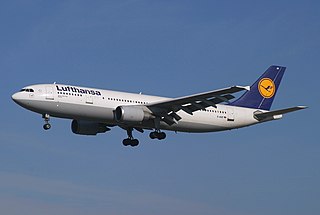
The Airbus A300 is Airbus's first production aircraft and the world's first twin-engine, double-aisle (wide-body) airliner, developed and manufactured by Airbus from 1971 to 2007.

The Airbus A310 is a wide-body aircraft, designed and manufactured by Airbus Industrie, then a consortium of European aerospace manufacturers. Airbus had identified a demand for an aircraft smaller than the A300, the first twin-jet wide-body. On 7 July 1978, the A310 was launched with orders from Swissair and Lufthansa. On 3 April 1982, the first prototype conducted its maiden flight, and the A310 received its type certificate on 11 March 1983.

Sultan Abdul Aziz Shah Airport, , often called Subang Airport or Subang Skypark, is an airport located in Subang, Petaling District, Selangor, Malaysia.
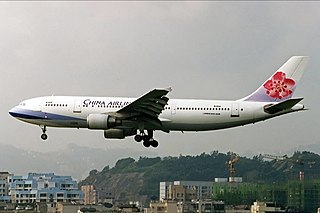
China Airlines Flight 676 was a scheduled international passenger flight. On Monday, 16 February 1998, the Airbus A300 jet airliner operating the flight crashed into a road and residential area in Tayuan, Taoyuan County, near Chiang Kai-shek International Airport, Taiwan.

Malaysian Airline System Flight 653 (MH653) was a scheduled domestic flight from Penang to Kuala Lumpur in Malaysia, operated by Malaysian Airline System (MAS). On the evening of 4 December 1977, the Boeing 737-200 aircraft flying the service crashed at Tanjung Kupang, Johor, Malaysia, while purportedly being diverted by hijackers to Singapore. It was the first fatal air crash for Malaysia Airlines, with all 93 passengers and 7 crew killed. It is also the deadliest aviation disaster to occur on Malaysian soil. The flight was apparently hijacked as soon as it reached cruise altitude. The circumstances in which the hijacking and subsequent crash occurred remain unsolved.

Pilot error generally refers to an accident in which an action or decision made by the pilot was the cause or a contributing factor that led to the accident, but also includes the pilot's failure to make a correct decision or take proper action. Errors are intentional actions that fail to achieve their intended outcomes. The Chicago Convention defines the term "accident" as "an occurrence associated with the operation of an aircraft [...] in which [...] a person is fatally or seriously injured [...] except when the injuries are [...] inflicted by other persons." Hence the definition of "pilot error" does not include deliberate crashing.

China Airlines Flight 140 was a regularly scheduled passenger flight from Chiang Kai-shek International Airport to Nagoya Airport in Nagoya, Japan.
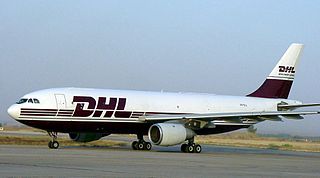
On 22 November 2003, shortly after takeoff from Baghdad, Iraq, an Airbus A300B2-200F cargo plane, registered OO-DLL and owned by the Belgian division of European Air Transport, was struck on the left wing by a surface-to-air missile while on a scheduled flight to Muharraq, Bahrain. Severe wing damage resulted in a fire and complete loss of hydraulic flight control systems. Because outboard left wing fuel tank 1A was full at takeoff, no fuel-air vapour explosion occurred. Liquid jet fuel dropped away as 1A disintegrated. Inboard fuel tank 1 was pierced and leaking.

Garuda Indonesia Flight 152 (GA152/GIA152) was a scheduled domestic flight operated by Garuda Indonesia from Soekarno-Hatta International Airport, Tangerang, to Polonia International Airport, Medan, in Indonesia. On 26 September 1997, the aircraft flying the route crashed into mountainous woodlands near the village of Buah Nabar, Sibolangit, killing all 222 passengers and 12 crew members on board. It is the deadliest aviation disaster in Indonesia's history.

Thai Airways International Flight 261 (TG261/THA261) was a scheduled domestic passenger flight from Bangkok's Don Mueang International Airport to Surat Thani International Airport in Surat Thani, Thailand. The flight was operated by Thai Airways International, the flag carrier of Thailand. On 11 December 1998, the aircraft, an Airbus A310-204 registered in Thailand as HS-TIA, stalled and crashed into a swamp during its landing attempt at Surat Thani Airport. A total of 101 people were killed in the crash.

Flying Tiger Line Flight 66 was a scheduled international cargo flight from Singapore Changi Airport to Hong Kong's Kai Tak Airport via a stopover at Kuala Lumpur International Airport, Malaysia. On February 19, 1989, the FedEx-owned Boeing 747-249F-SCD crashed while on its final approach. The aircraft impacted a hillside 437 ft (133 m) above sea level and 12 km from Kuala Lumpur, resulting in all four crew members being killed.

Japan Air Lines Flight 715 was an airplane that crashed in Malaysia on 27 September 1977. It was a McDonnell Douglas DC-8, registration JA8051, on a flight from Haneda Airport in Tokyo, Japan, to Singapore International Airport in Singapore, with stopovers at Kai Tak Airport in Kowloon Bay, Hong Kong, and Sultan Abdul Aziz Shah Airport in Subang, Malaysia. Ten crew and 69 passengers were on board. It was the second-deadliest aviation disaster to occur in Malaysia at the time.
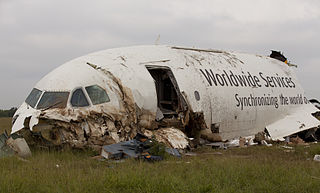
UPS Airlines Flight 1354 (5X1354/UPS1354) was a scheduled cargo flight from Louisville, Kentucky, to Birmingham, Alabama. On August 14, 2013, the Airbus A300 flying the route crashed and burst into flames short of the runway on approach to Birmingham–Shuttlesworth International Airport. Both pilots were pronounced dead at the scene of the crash. They were the only people aboard the aircraft. It was the second fatal air crash for UPS Airlines.

Aeroflot Flight N-528 was a regular commercial flight from Odesa to Berdyansk that crashed at11:22 local time while attempting to land in poor weather conditions.

Asiana Airlines Flight 162 was a regular short-haul international passenger flight from Incheon International Airport near Seoul, South Korea, to Hiroshima Airport in Hiroshima, Japan. On 14 April 2015, the Airbus A320-232 aircraft touched down short of the runway, struck the localizer array, skidded onto the runway on its tail, and spun 120 degrees before finally coming to a rest on the grass, opposite the terminal building. The aircraft suffered substantial damage to the left wing and engine. Of the 82 people aboard, 27 were injured, one seriously.

Korean Air Flight 631 (KE631/KAL631) was a scheduled passenger flight from Incheon International Airport near Seoul, South Korea to Mactan–Cebu International Airport in Metro Cebu, Philippines. On October 23, 2022, the Airbus A330-300 operating this flight overran the runway while landing in Cebu due to hydraulic failure. Despite what reports described as a "terrifying close call," all passengers and crew members survived without injuries. However, the aircraft was damaged beyond repair and written off as a result of the accident, making it the 14th hull loss of an Airbus A330.
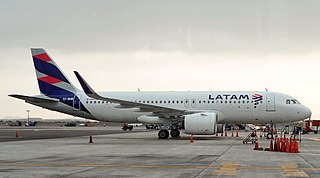
LATAM Airlines Perú Flight 2213 was a scheduled domestic passenger flight in Peru from Lima to Juliaca. On 18 November 2022, the Airbus A320neo was taking off from Jorge Chávez International Airport when it collided with a fire engine that was crossing the runway, killing two firefighters and injuring a third, who died of his injuries seven months later. 40 passengers were injured. The aircraft was damaged beyond repair and written off, making it the first hull loss of the Airbus A320neo family.

















